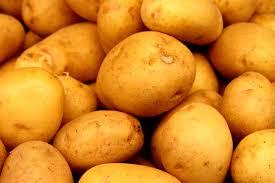
We've been praising the development of Golden Rice, genetically engineered to contain the vitamin A precursor beta-carotene, for years. Since vitamin A deficiency causes hundreds of thousands of cases of childhood blindness around the world, it only makes sense to add this means of supplementing beta-carotene in areas of the world where rice is a staple. In other areas, such as some parts of Africa, potatoes, not rice provide the basis of diets. The good news is that there is hope for these areas as well, as strains of potatoes engineered to contain not only beta-carotene but also alpha-tocopherol, or Vitamin E, have been developed.
Potatoes are a gift of the New World to the Old, providing calories, starch, vitamin C, and fiber — but virtually no vitamin A. Even the yellow potatoes we can currently buy in the supermarket aren't sources of beta-carotene — there are other chemicals that confer the yellow color. However, writing in PLOS One, Dr. Chureeporn Chitchumroonchokchai from the Ohio State University and colleagues evaluate the nutrient contributions of 2 strains of genetically engineered potatoes.
The investigators compared the bioavailability of beta-carotene and alpha-tocopherol from potatoes transformed with three enzymes from the bacterium Erwinia herbicola. They used an in vitro system to digest boiled cubes of both wild-type (WT) and transformed potatoes (Golden Potatoes or GP), and then determined the uptake of the nutrients by human intestinal cells.
First, they determined that the GP potatoes contained 6-8 times more total carotenoids than did the WT versions. Beta-carotene and alpha-carotene (a minor contributor to vitamin A) concentrations were over 100 times greater in GP than WT potatoes. After in vitro digestion, human intestinal cells were incubated with extracts of the GP potatoes for 4 hours (there weren't enough carotenes in the WT to allow this determination).
Alpha-tocopherol was best absorbed--about 53 percent, and beta-carotene anywhere from 15 to 18 percent. These data indicate that not only was the transformation of GP effective in introducing the beta-carotene and alpha-tocopherol to the potatoes, but both were able to withstand cooking and digestion and were taken up by intestinal cells.
Of course, we can't expect to see GP in stores, here or in developing countries any time soon — they must undergo further testing — probably in animal models as well as people before they can be widely disseminated. However, these data provide hope that in areas that use potatoes as a basic staple food, GP will help prevent both childhood blindness as well as the impaired immunity that accompanies vitamin A deficiency.



